Unit 4 Where's my schoolbag?教案(共5课时) 2024-2025学年人教版英语七年级上册
文档属性
| 名称 | Unit 4 Where's my schoolbag?教案(共5课时) 2024-2025学年人教版英语七年级上册 |
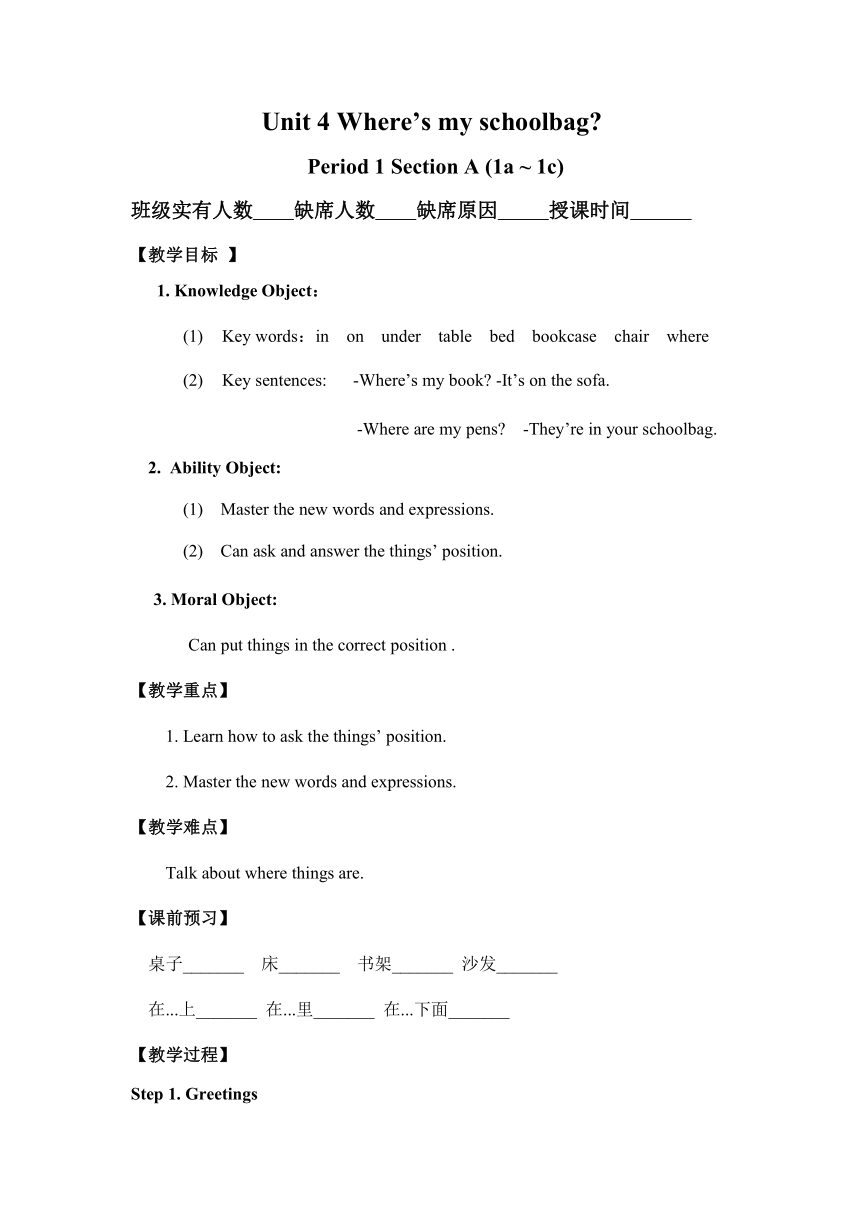
|
|
| 格式 | docx | ||
| 文件大小 | 46.9KB | ||
| 资源类型 | 教案 | ||
| 版本资源 | 人教新目标(Go for it)版 | ||
| 科目 | 英语 | ||
| 更新时间 | 2024-06-16 20:25:09 | ||
图片预览

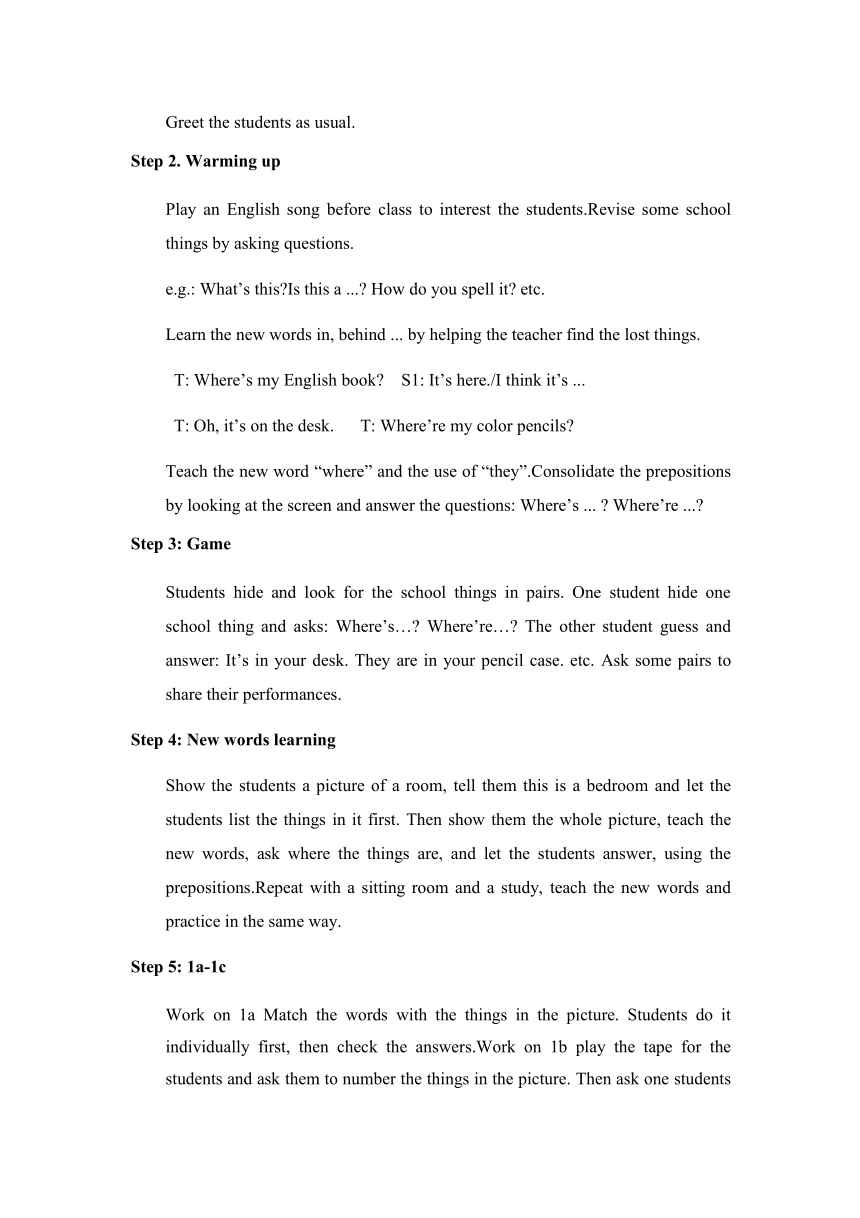
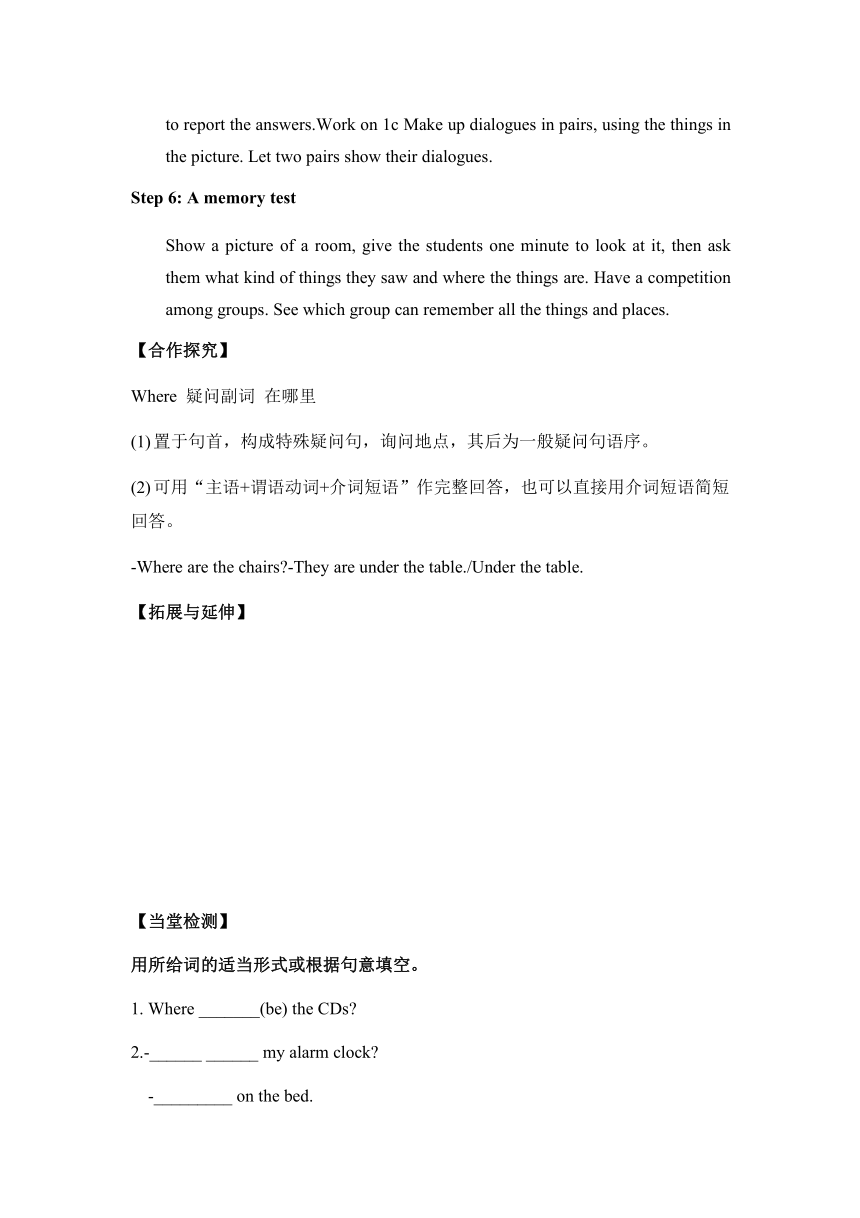
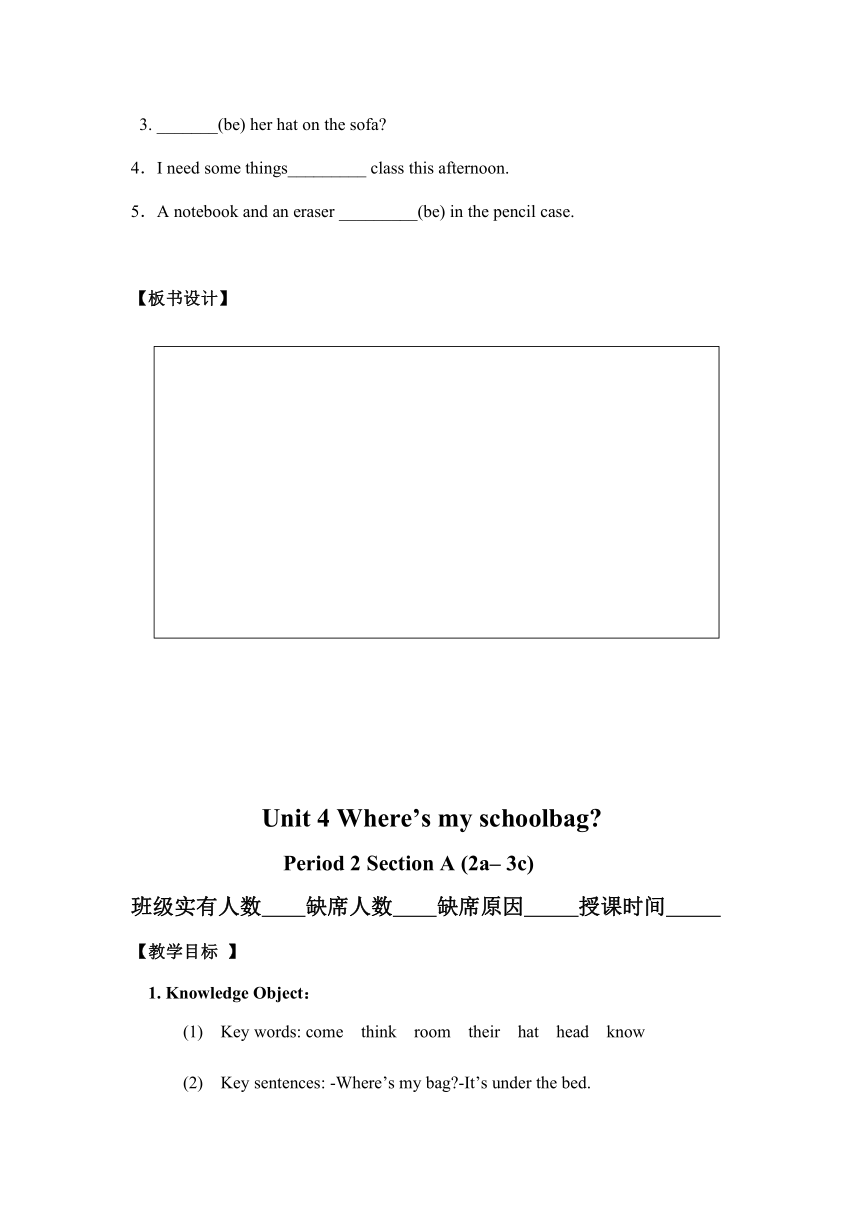
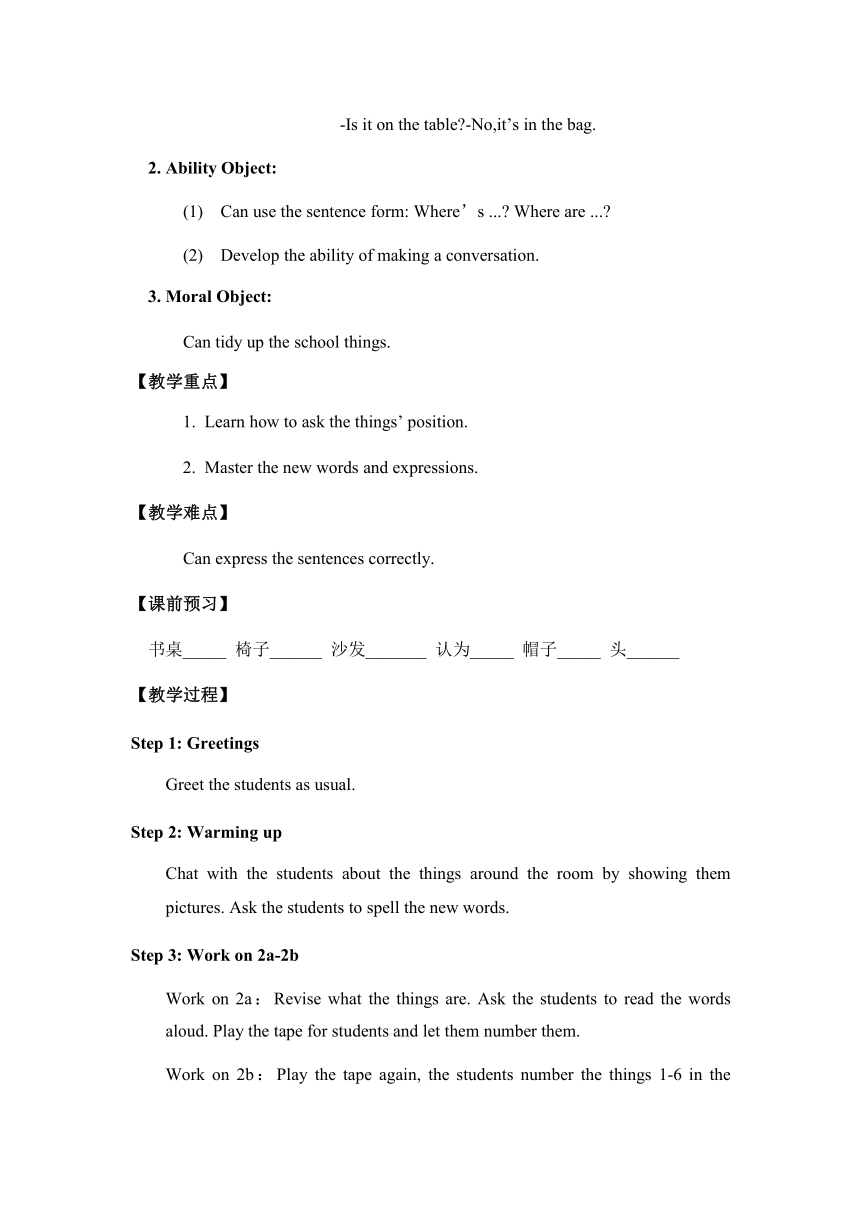
文档简介
Unit 4 Where’s my schoolbag
Period 1 Section A (1a ~ 1c)
班级实有人数 缺席人数 缺席原因 授课时间
【教学目标 】
1. Knowledge Object:
Key words:in on under table bed bookcase chair where
Key sentences: -Where’s my book -It’s on the sofa.
-Where are my pens -They’re in your schoolbag.
Ability Object:
Master the new words and expressions.
Can ask and answer the things’ position.
3. Moral Object:
Can put things in the correct position .
【教学重点】
1. Learn how to ask the things’ position.
2. Master the new words and expressions.
【教学难点】
Talk about where things are.
【课前预习】
桌子_______ 床_______ 书架_______ 沙发_______
在...上_______ 在...里_______ 在...下面_______
【教学过程】
Step 1. Greetings
Greet the students as usual.
Step 2. Warming up
Play an English song before class to interest the students.Revise some school things by asking questions.
e.g.: What’s this Is this a ... How do you spell it etc.
Learn the new words in, behind ... by helping the teacher find the lost things.
T: Where’s my English book S1: It’s here./I think it’s ...
T: Oh, it’s on the desk. T: Where’re my color pencils
Teach the new word “where” and the use of “they”.Consolidate the prepositions by looking at the screen and answer the questions: Where’s ... Where’re ...
Step 3: Game
Students hide and look for the school things in pairs. One student hide one school thing and asks: Where’s… Where’re… The other student guess and answer: It’s in your desk. They are in your pencil case. etc. Ask some pairs to share their performances.
Step 4: New words learning
Show the students a picture of a room, tell them this is a bedroom and let the students list the things in it first. Then show them the whole picture, teach the new words, ask where the things are, and let the students answer, using the prepositions.Repeat with a sitting room and a study, teach the new words and practice in the same way.
Step 5: 1a-1c
Work on 1a Match the words with the things in the picture. Students do it individually first, then check the answers.Work on 1b play the tape for the students and ask them to number the things in the picture. Then ask one students to report the answers.Work on 1c Make up dialogues in pairs, using the things in the picture. Let two pairs show their dialogues.
Step 6: A memory test
Show a picture of a room, give the students one minute to look at it, then ask them what kind of things they saw and where the things are. Have a competition among groups. See which group can remember all the things and places.
【合作探究】
Where 疑问副词 在哪里
置于句首,构成特殊疑问句,询问地点,其后为一般疑问句语序。
可用“主语+谓语动词+介词短语”作完整回答,也可以直接用介词短语简短回答。
-Where are the chairs -They are under the table./Under the table.
【拓展与延伸】
【当堂检测】
用所给词的适当形式或根据句意填空。
1. Where _______(be) the CDs
2.-______ ______ my alarm clock
-_________ on the bed.
3. _______(be) her hat on the sofa
4.I need some things_________ class this afternoon.
5.A notebook and an eraser _________(be) in the pencil case.
【板书设计】
Unit 4 Where’s my schoolbag
Period 2 Section A (2a– 3c)
班级实有人数 缺席人数 缺席原因 授课时间
【教学目标 】
1. Knowledge Object:
(1) Key words: come think room their hat head know
(2) Key sentences: -Where’s my bag -It’s under the bed.
-Is it on the table -No,it’s in the bag.
2. Ability Object:
(1) Can use the sentence form: Where’s ... Where are ...
(2) Develop the ability of making a conversation.
3. Moral Object:
Can tidy up the school things.
【教学重点】
Learn how to ask the things’ position.
Master the new words and expressions.
【教学难点】
Can express the sentences correctly.
【课前预习】
书桌_____ 椅子______ 沙发_______ 认为_____ 帽子_____ 头______
【教学过程】
Step 1: Greetings
Greet the students as usual.
Step 2: Warming up
Chat with the students about the things around the room by showing them pictures. Ask the students to spell the new words.
Step 3: Work on 2a-2b
Work on 2a:Revise what the things are. Ask the students to read the words aloud. Play the tape for students and let them number them.
Work on 2b:Play the tape again, the students number the things 1-6 in the picture. Imitate the dialogues.
Step 4: Practice
A guessing game. Show the students a picture of a room with a few things in it. Have them guess the places of the other things.
e.g.: T: There is a bookcase in it. Is the bookcase near the bed
Ss: Yes, it is., it isn’t.
Write the general question and the answers on the blackboard.
Look at the picture in 2b again. The students use general questions to ask and answer about the things in it.
Step 5: Work on 3c Find the difference
Student A looks at Picture 1 (Textbook P21). Student B looks at Picture 2 (Textbook P19 1a). Ask and answer in pairs and fill in the form.
e.g.: Sa: Where is the schoolbag Is it under the table
Sb: No, it isn’t. It’s on the table.
Step 6: Practice the drill “Where is/are ... ”
1. Work on 2d Role-play the conversation.
Ask the students to read the dialogue in pairs and then let two pairs act it out.
2.Present short dialogues, using pictures or objects to help.
A: Where’s my bag
B: I don’t know. Is it on the sofa
A: No, it isn’t.
A: Where’re my books
B: I don’t know. Are they on the bed
A: Yes, they are. Teach “don’t=do not”, “know”.
Let the students make similar dialogues according to the pictures in 3a and 3b.
After they have finished the exercise, let one or two students report their answers.
Step 7: Homework
Finish off the exercises in the exercise books.Act out the dialogues.
【合作探究】
复数名词的所有格
以-s结尾的复数名词,在词尾直接加“’”构成名词所有格。my parents’ room我父母的房间
不以-s结尾的复数名词,在词尾加“’”构成名词所有格。men’s bags男士包
don’t(助动词do与否定副词not的缩写)
含有实义动词的句子在变形成否定句时,需要借助______或______,don’t/doesn’t后用_________。
【拓展与延伸】
【当堂检测】
翻译下列词组
1.在课桌下面 ________________ 2.在沙发上面 ________________
3.在背包里 ________________ 4.在抽屉里 ________________
5.在椅子背后 _______________ 6.在电话旁边 ________________
【板书设计】
Unit 4 Where’s my schoolbag
Period 3 Section B (1a-1e)
班级实有人数 缺席人数 缺席原因 授课时间
【教学目标】
1. Knowledge Object:
(1) Key words: radio clock tape player tape player
(2) Key sentences: The English books are under the radio.
The ruler is on the bed.
2. Ability Object:
(1) Master the new words and expressions.
(2) Master the use of preposition: in, on, under
3. Moral Object:
Cultivate students to communicate with friends and introduce where thing
are.
【教学重点】
1. Using preposition: in, on, under
2. Master the new words and expressions
【教学难点】
Use the sentence patterns to make dialogues.
【课前预习】英汉互译.
radio clock tape player
tape hat model plane
【教学过程】
Step 1: Warming- up and revision
1. Greeting the Ss. Check the homework.
2. Review the school things we learned in Section A. Let Ss say the school things they have.
Step 2: New words learning
Show the students a picture of a room. Let the students say like this: The ID card is on the table. The books are on the chair.Let some students list some new words. Practice reading them.Match the new words with the things in the picture in 1a.
Pair work. Talk about the picture in 1b.
Step 3: Listening
1. Work on 1c.
Play the recording twice. Students listen and circle the items. And check the answers with the class.
2. Work on 1d.
Play the recording for the students to write down the sentences. And then check the answers with the class.
Step 4: Pair work
Make a conversation and practice it. Let some pairs act out their conversations.
【合作探究】
radio 名词,收音机;无线电广播。复数形式为radios.
listen to the radio 听收音机
on the radio 通过广播/收音机
My grandfather has two radios.
【拓展与延伸】
【当堂检测】
句型转换
1.We are in Beijing. (就划线部分提问)
________ ________ we
Can you bring the ruler to me (作出否定回答)
No, ________ ________.
3.I draw pictures on the wall. (变为否定句)
I ________ ________ pictures on the wall.
4.We have two new students in our class. (变为同义句)
________ ________ two new students in our class.
5.There’s an English book in the desk. (变为复数句)
________ ________ English ________ in the desks.
【板书设计】
Unit 4 Where’s my schoolbag
Period 4 Section B (2a~2c)
班级实有人数 缺席人数 缺席原因 授课时间
【教学目标】
1. Knowledge Object:
Key words: tidy but our everywhere always
Key sentences: I’m tidy, but Gina is not.
In my room, my books and tapes are in the bookcases.
Gina’s books are everywhere.
2. Ability Object:
Improve the reading skills.
Master the new words.
3. Moral Object:
Be able to read some simple find and find instructions
【教学重点】
Train students to read the passage to get information
【教学难点】
Use reading strategies to guide students to read passages.
【课前预习】英汉互译.
整洁的 但是 我们的
处处,到处 总是 书架,书柜
【教学过程】
Step 1: Warming- up and revision
Greeting the Ss. Check the homework.
Step 2: Work on 2a.
Write the words you know for the things in the picture.Get the students to look at the picture carefully and write the things down.While they are doing, the teacher goes around the classroom to check.
Step 3: Find the differences
Show a picture of a room with a few things in it, give the students a short note about the things around the room to read and let the students try to find out the differences between the reading material and the picture. Circle the mistakes in the reading material. Make an oral report by looking at the picture again.
Step 4: Work on 2b
Work on 2b: Reading. The students read the passage silently and answer the questions.
Step 5: Work on 2c
Work on 2c :After reading the passage, let the students fill in the chart .
Check the answers.
Practice reading passage aloud.
Step 6: Homework
Communicate with classmates by using sentences.
【合作探究】
tidy ① 形容词,整洁的,井井有条的。即可放在联系动词的后面作表语,也可放在名词的前面作定语。tidy的反义词为untidy, 意为“不整洁的,凌乱的”
keep tidy 保持整洁
The room is tidy.
② 动词,使整洁。后面可接名词或代词作宾语。
Tidy your room, Tom.
【拓展延伸】
【当堂检测】
1. His baseball is under the table.(变为一般疑问句)
______his baseball _______ the table
2. His dresser is next to his bed. (变为否定句)
His dresser _____ _______ next to his bed.
3. My keys are on the sofa.(对划线部分提问)
_________ ______ my keys
4. Mike is behind the door. (对划线部分提问)
_______ ______ behind the door
板书设计】
Unit 4 Where’s my schoolbag
Period 5 Section B (3a~self check)
班级实有人数 缺席人数 缺席原因 授课时间
【教学目标】
1. Knowledge Objective :
(1) Key words: radio, tapes, dictionary, desk, under
(2) Key sentences: My dictionary and my radio are on the desk.
My pencil box is in my schoolbag and my schoolbag is under the desk.
2. Ability Objective:
(1) The ability to ask where things are by using in, under and on.
(2) Make use of the sentence patterns to write a composition.
3. Moral Object:
By writing about where the things are in your room, cultivate students' self-care ability.
【教学重难点】
The ability to talk where things are.
【课前预习】
一个铅笔盒 一个书包 一本字典
在我的书桌上 在床下面 在你头上
【教学过程】
Step 1: Warming up and revision
1. Show some things (learned in Section B) and ask the students about them. (Using where is the .../where are the... ) Let other students answer the questions by using the words in, on, under.
Step 2: Presentation
(put a book on the desk)
T: where is the book
Ss: It’s on the desk.
Step 3: Writing
1. Let’s work on 3a. Look at the chart do you have these things Where are they And finish 3a.
2. Ask some Ss read the words in the chart. And answer where is the thing.
3. Check the answers.
Step 4 : Self Check
1. Fill in the blanks with words they have learned .
2. Let the students do Self Check 2 individually.
3. Show some good passages on the screen and ask the students to learn from these students.
Step 5: Writing
Write a short passage to describe things in your room.
【当堂检测】
1.The map is the wall.(在…上)
2.Your brother’s CDs are the drawer.(在…里)
3.Two dogs are the sofa.(在…下)
4.-他的书包在哪里?
-在书桌下面。
- his schoolbag
-It’s the desk.
5 他的钢笔不在书包里。
His pen the schoolbag.
【板书设计】
【教学反思】
Period 1 Section A (1a ~ 1c)
班级实有人数 缺席人数 缺席原因 授课时间
【教学目标 】
1. Knowledge Object:
Key words:in on under table bed bookcase chair where
Key sentences: -Where’s my book -It’s on the sofa.
-Where are my pens -They’re in your schoolbag.
Ability Object:
Master the new words and expressions.
Can ask and answer the things’ position.
3. Moral Object:
Can put things in the correct position .
【教学重点】
1. Learn how to ask the things’ position.
2. Master the new words and expressions.
【教学难点】
Talk about where things are.
【课前预习】
桌子_______ 床_______ 书架_______ 沙发_______
在...上_______ 在...里_______ 在...下面_______
【教学过程】
Step 1. Greetings
Greet the students as usual.
Step 2. Warming up
Play an English song before class to interest the students.Revise some school things by asking questions.
e.g.: What’s this Is this a ... How do you spell it etc.
Learn the new words in, behind ... by helping the teacher find the lost things.
T: Where’s my English book S1: It’s here./I think it’s ...
T: Oh, it’s on the desk. T: Where’re my color pencils
Teach the new word “where” and the use of “they”.Consolidate the prepositions by looking at the screen and answer the questions: Where’s ... Where’re ...
Step 3: Game
Students hide and look for the school things in pairs. One student hide one school thing and asks: Where’s… Where’re… The other student guess and answer: It’s in your desk. They are in your pencil case. etc. Ask some pairs to share their performances.
Step 4: New words learning
Show the students a picture of a room, tell them this is a bedroom and let the students list the things in it first. Then show them the whole picture, teach the new words, ask where the things are, and let the students answer, using the prepositions.Repeat with a sitting room and a study, teach the new words and practice in the same way.
Step 5: 1a-1c
Work on 1a Match the words with the things in the picture. Students do it individually first, then check the answers.Work on 1b play the tape for the students and ask them to number the things in the picture. Then ask one students to report the answers.Work on 1c Make up dialogues in pairs, using the things in the picture. Let two pairs show their dialogues.
Step 6: A memory test
Show a picture of a room, give the students one minute to look at it, then ask them what kind of things they saw and where the things are. Have a competition among groups. See which group can remember all the things and places.
【合作探究】
Where 疑问副词 在哪里
置于句首,构成特殊疑问句,询问地点,其后为一般疑问句语序。
可用“主语+谓语动词+介词短语”作完整回答,也可以直接用介词短语简短回答。
-Where are the chairs -They are under the table./Under the table.
【拓展与延伸】
【当堂检测】
用所给词的适当形式或根据句意填空。
1. Where _______(be) the CDs
2.-______ ______ my alarm clock
-_________ on the bed.
3. _______(be) her hat on the sofa
4.I need some things_________ class this afternoon.
5.A notebook and an eraser _________(be) in the pencil case.
【板书设计】
Unit 4 Where’s my schoolbag
Period 2 Section A (2a– 3c)
班级实有人数 缺席人数 缺席原因 授课时间
【教学目标 】
1. Knowledge Object:
(1) Key words: come think room their hat head know
(2) Key sentences: -Where’s my bag -It’s under the bed.
-Is it on the table -No,it’s in the bag.
2. Ability Object:
(1) Can use the sentence form: Where’s ... Where are ...
(2) Develop the ability of making a conversation.
3. Moral Object:
Can tidy up the school things.
【教学重点】
Learn how to ask the things’ position.
Master the new words and expressions.
【教学难点】
Can express the sentences correctly.
【课前预习】
书桌_____ 椅子______ 沙发_______ 认为_____ 帽子_____ 头______
【教学过程】
Step 1: Greetings
Greet the students as usual.
Step 2: Warming up
Chat with the students about the things around the room by showing them pictures. Ask the students to spell the new words.
Step 3: Work on 2a-2b
Work on 2a:Revise what the things are. Ask the students to read the words aloud. Play the tape for students and let them number them.
Work on 2b:Play the tape again, the students number the things 1-6 in the picture. Imitate the dialogues.
Step 4: Practice
A guessing game. Show the students a picture of a room with a few things in it. Have them guess the places of the other things.
e.g.: T: There is a bookcase in it. Is the bookcase near the bed
Ss: Yes, it is., it isn’t.
Write the general question and the answers on the blackboard.
Look at the picture in 2b again. The students use general questions to ask and answer about the things in it.
Step 5: Work on 3c Find the difference
Student A looks at Picture 1 (Textbook P21). Student B looks at Picture 2 (Textbook P19 1a). Ask and answer in pairs and fill in the form.
e.g.: Sa: Where is the schoolbag Is it under the table
Sb: No, it isn’t. It’s on the table.
Step 6: Practice the drill “Where is/are ... ”
1. Work on 2d Role-play the conversation.
Ask the students to read the dialogue in pairs and then let two pairs act it out.
2.Present short dialogues, using pictures or objects to help.
A: Where’s my bag
B: I don’t know. Is it on the sofa
A: No, it isn’t.
A: Where’re my books
B: I don’t know. Are they on the bed
A: Yes, they are. Teach “don’t=do not”, “know”.
Let the students make similar dialogues according to the pictures in 3a and 3b.
After they have finished the exercise, let one or two students report their answers.
Step 7: Homework
Finish off the exercises in the exercise books.Act out the dialogues.
【合作探究】
复数名词的所有格
以-s结尾的复数名词,在词尾直接加“’”构成名词所有格。my parents’ room我父母的房间
不以-s结尾的复数名词,在词尾加“’”构成名词所有格。men’s bags男士包
don’t(助动词do与否定副词not的缩写)
含有实义动词的句子在变形成否定句时,需要借助______或______,don’t/doesn’t后用_________。
【拓展与延伸】
【当堂检测】
翻译下列词组
1.在课桌下面 ________________ 2.在沙发上面 ________________
3.在背包里 ________________ 4.在抽屉里 ________________
5.在椅子背后 _______________ 6.在电话旁边 ________________
【板书设计】
Unit 4 Where’s my schoolbag
Period 3 Section B (1a-1e)
班级实有人数 缺席人数 缺席原因 授课时间
【教学目标】
1. Knowledge Object:
(1) Key words: radio clock tape player tape player
(2) Key sentences: The English books are under the radio.
The ruler is on the bed.
2. Ability Object:
(1) Master the new words and expressions.
(2) Master the use of preposition: in, on, under
3. Moral Object:
Cultivate students to communicate with friends and introduce where thing
are.
【教学重点】
1. Using preposition: in, on, under
2. Master the new words and expressions
【教学难点】
Use the sentence patterns to make dialogues.
【课前预习】英汉互译.
radio clock tape player
tape hat model plane
【教学过程】
Step 1: Warming- up and revision
1. Greeting the Ss. Check the homework.
2. Review the school things we learned in Section A. Let Ss say the school things they have.
Step 2: New words learning
Show the students a picture of a room. Let the students say like this: The ID card is on the table. The books are on the chair.Let some students list some new words. Practice reading them.Match the new words with the things in the picture in 1a.
Pair work. Talk about the picture in 1b.
Step 3: Listening
1. Work on 1c.
Play the recording twice. Students listen and circle the items. And check the answers with the class.
2. Work on 1d.
Play the recording for the students to write down the sentences. And then check the answers with the class.
Step 4: Pair work
Make a conversation and practice it. Let some pairs act out their conversations.
【合作探究】
radio 名词,收音机;无线电广播。复数形式为radios.
listen to the radio 听收音机
on the radio 通过广播/收音机
My grandfather has two radios.
【拓展与延伸】
【当堂检测】
句型转换
1.We are in Beijing. (就划线部分提问)
________ ________ we
Can you bring the ruler to me (作出否定回答)
No, ________ ________.
3.I draw pictures on the wall. (变为否定句)
I ________ ________ pictures on the wall.
4.We have two new students in our class. (变为同义句)
________ ________ two new students in our class.
5.There’s an English book in the desk. (变为复数句)
________ ________ English ________ in the desks.
【板书设计】
Unit 4 Where’s my schoolbag
Period 4 Section B (2a~2c)
班级实有人数 缺席人数 缺席原因 授课时间
【教学目标】
1. Knowledge Object:
Key words: tidy but our everywhere always
Key sentences: I’m tidy, but Gina is not.
In my room, my books and tapes are in the bookcases.
Gina’s books are everywhere.
2. Ability Object:
Improve the reading skills.
Master the new words.
3. Moral Object:
Be able to read some simple find and find instructions
【教学重点】
Train students to read the passage to get information
【教学难点】
Use reading strategies to guide students to read passages.
【课前预习】英汉互译.
整洁的 但是 我们的
处处,到处 总是 书架,书柜
【教学过程】
Step 1: Warming- up and revision
Greeting the Ss. Check the homework.
Step 2: Work on 2a.
Write the words you know for the things in the picture.Get the students to look at the picture carefully and write the things down.While they are doing, the teacher goes around the classroom to check.
Step 3: Find the differences
Show a picture of a room with a few things in it, give the students a short note about the things around the room to read and let the students try to find out the differences between the reading material and the picture. Circle the mistakes in the reading material. Make an oral report by looking at the picture again.
Step 4: Work on 2b
Work on 2b: Reading. The students read the passage silently and answer the questions.
Step 5: Work on 2c
Work on 2c :After reading the passage, let the students fill in the chart .
Check the answers.
Practice reading passage aloud.
Step 6: Homework
Communicate with classmates by using sentences.
【合作探究】
tidy ① 形容词,整洁的,井井有条的。即可放在联系动词的后面作表语,也可放在名词的前面作定语。tidy的反义词为untidy, 意为“不整洁的,凌乱的”
keep tidy 保持整洁
The room is tidy.
② 动词,使整洁。后面可接名词或代词作宾语。
Tidy your room, Tom.
【拓展延伸】
【当堂检测】
1. His baseball is under the table.(变为一般疑问句)
______his baseball _______ the table
2. His dresser is next to his bed. (变为否定句)
His dresser _____ _______ next to his bed.
3. My keys are on the sofa.(对划线部分提问)
_________ ______ my keys
4. Mike is behind the door. (对划线部分提问)
_______ ______ behind the door
板书设计】
Unit 4 Where’s my schoolbag
Period 5 Section B (3a~self check)
班级实有人数 缺席人数 缺席原因 授课时间
【教学目标】
1. Knowledge Objective :
(1) Key words: radio, tapes, dictionary, desk, under
(2) Key sentences: My dictionary and my radio are on the desk.
My pencil box is in my schoolbag and my schoolbag is under the desk.
2. Ability Objective:
(1) The ability to ask where things are by using in, under and on.
(2) Make use of the sentence patterns to write a composition.
3. Moral Object:
By writing about where the things are in your room, cultivate students' self-care ability.
【教学重难点】
The ability to talk where things are.
【课前预习】
一个铅笔盒 一个书包 一本字典
在我的书桌上 在床下面 在你头上
【教学过程】
Step 1: Warming up and revision
1. Show some things (learned in Section B) and ask the students about them. (Using where is the .../where are the... ) Let other students answer the questions by using the words in, on, under.
Step 2: Presentation
(put a book on the desk)
T: where is the book
Ss: It’s on the desk.
Step 3: Writing
1. Let’s work on 3a. Look at the chart do you have these things Where are they And finish 3a.
2. Ask some Ss read the words in the chart. And answer where is the thing.
3. Check the answers.
Step 4 : Self Check
1. Fill in the blanks with words they have learned .
2. Let the students do Self Check 2 individually.
3. Show some good passages on the screen and ask the students to learn from these students.
Step 5: Writing
Write a short passage to describe things in your room.
【当堂检测】
1.The map is the wall.(在…上)
2.Your brother’s CDs are the drawer.(在…里)
3.Two dogs are the sofa.(在…下)
4.-他的书包在哪里?
-在书桌下面。
- his schoolbag
-It’s the desk.
5 他的钢笔不在书包里。
His pen the schoolbag.
【板书设计】
【教学反思】
同课章节目录
- starters 预备篇(2012秋审查)
- Unit 1 Good morning !
- Unit 2 What’s this in English?
- Unit 3 What color is it ?
- Unit 1 My name's Gina.
- Section A
- Section B
- Unit 2 This is my sister.
- Section A
- Section B
- Unit 3 Is this your pencil?
- Section A
- Section B
- Unit 4 Where's my schoolbag?
- Section A
- Section B
- Unit 5 Do you have a soccer ball?
- Section A
- Section B
- Unit 6 Do you like bananas?
- Section A
- Section B
- Unit 7 How much are these socks?
- Section A
- Section B
- Unit 8 When is your birthday?
- Section A
- Section B
- Unit 9 My favorite subject is science.
- Section A
- Section B
